Estimates
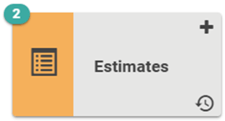
Go to Estimates
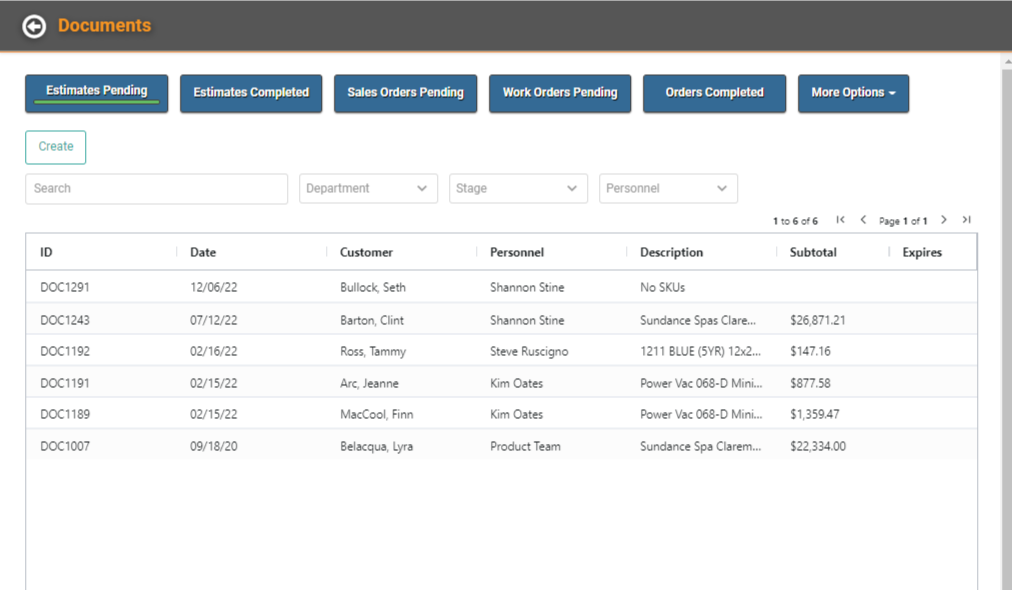
Estimates appear on a larger Documents Search page where you can quickly access your Sales Orders and Work Orders as well. There are fields to filter your view by Document Type, Status, Department, and Date Range.
Create an Estimate
- To create a new Estimate, click
 .
. - Select the Customer.
- Select the Department.
- Select the Distribution Method.
- Select the Document Type.
- Enter optional Instructions.
- Click

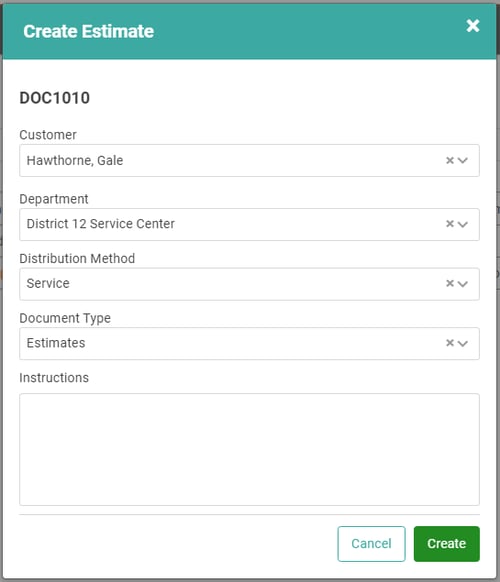
Once you have created the Estimate, the Estimates Document Update screen will come up.
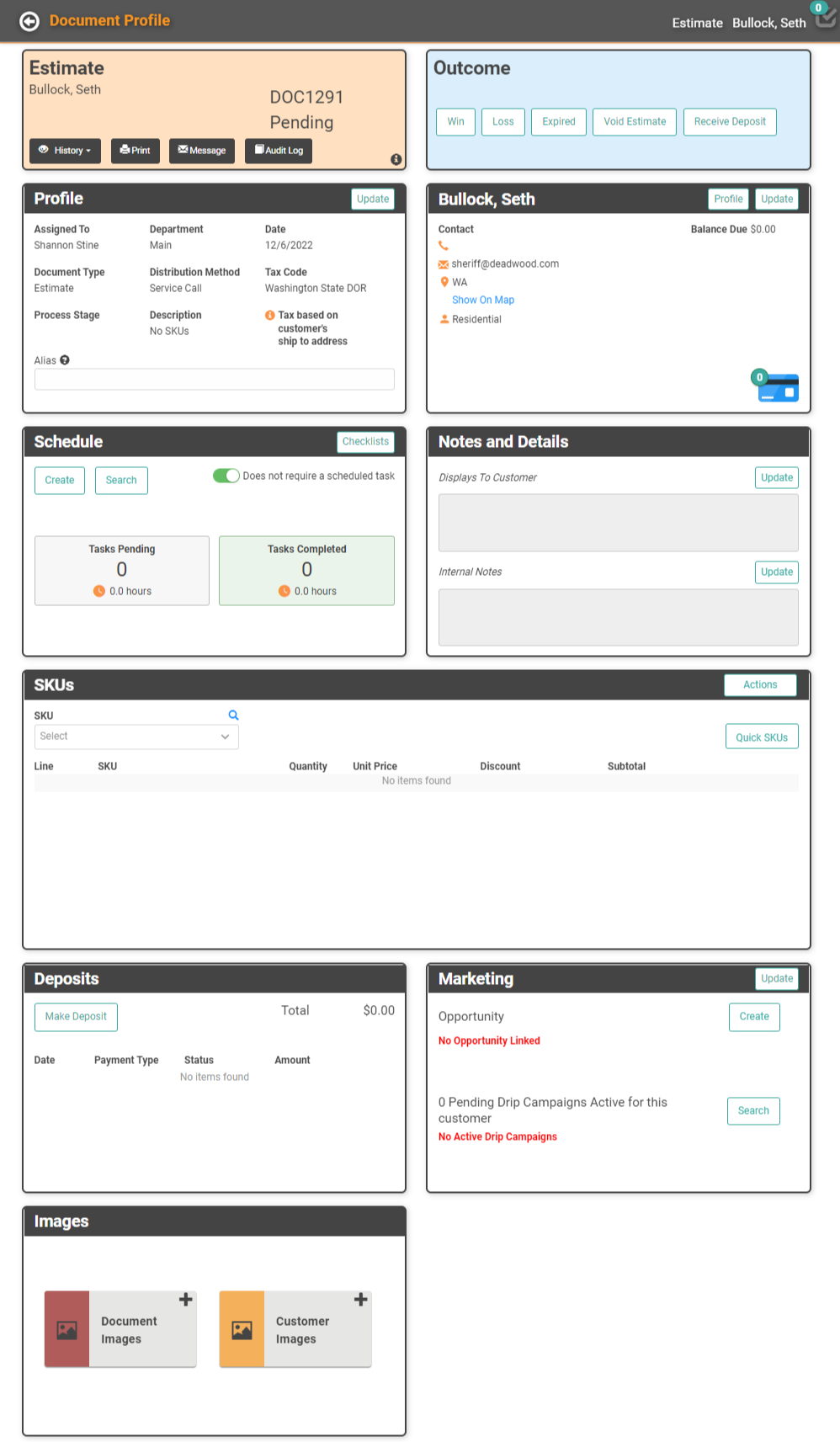
Profile
If there’s anything to update in the Profile box, you can click Update.

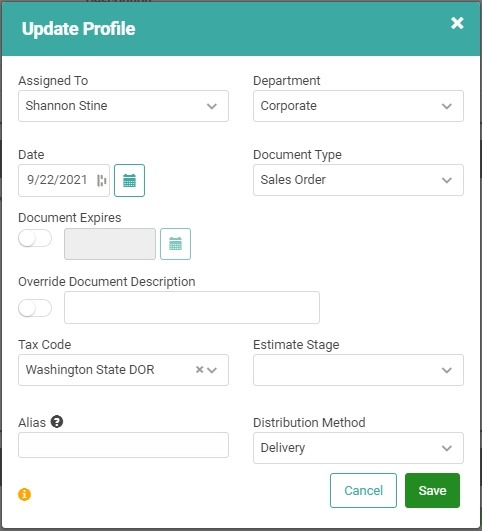
You can give the Document an Expiration Date, Override the Document Description which defaults to the Document Type, add an Estimate Stage, add an Alias, or update the existing information.
IMPORTANT! As with all Documents in LOU, the default Tax Code is the Department Tax Code. If you need to update the Tax Code for Destination Based Tax, you should do so here.
Once you’ve updated everything, click
 .
. Customer Information
You can click Map to see a map of the Ship To address, Profile to head to the Customer Profile, or Update to update the Customer information, including Billing and Shipping Addresses.

When you click Update, a pop-up will allow you to make changes to the Customer Information.
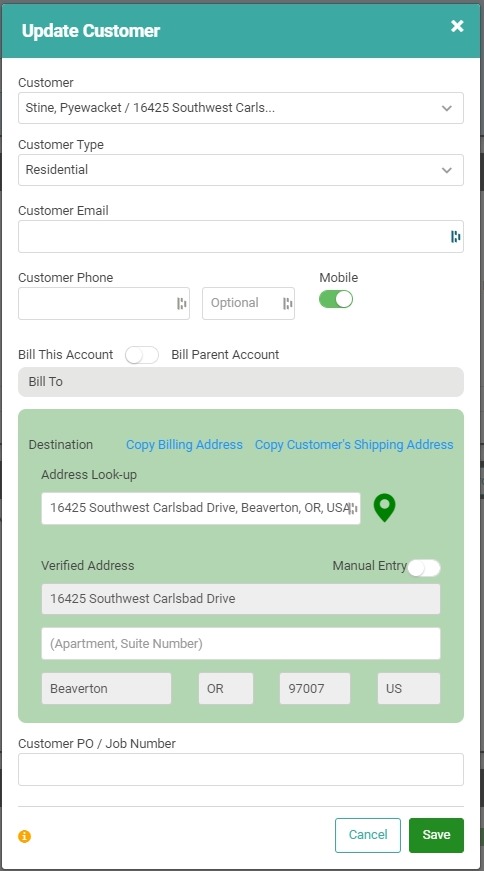
Be sure to click
 after entering the information.
after entering the information. When you click Profile, you’ll be taken to the Customer Profile. You can use the back arrow in LOU to go right back to the Estimate.
You can use the
 to update or add a Card on File.
to update or add a Card on File. Schedule & Notes and Details
If the items included in the Estimate require a scheduled task, you can create that information in the Schedule box. You can add both Customer-Facing and Internal notes in the Notes and Details box.
The Schedule box also contains a button to access and complete Checklists.

Since it’s less common that an Estimate would require a Schedule Task, the Does not require a scheduled task option is toggled on. To create a Schedule Task toggle that option off. Scheduling and completing the Schedule Tasks will function just as they do when associated with a Work Order or Sales Order with exception to being Invoiced.
The Displays to Customer Notes field is a great place to include important information the customer will need to know. You can use this field for anything you want to track on the Estimate and display to the Customer which doesn’t have its own field.
Internal Notes will not display on Customer-facing documents (printed and electronic).
REMEMBER! Note fields are limited to 500 characters. This includes spaces.
SKUs
In the SKUs box you can add the SKUs for the order. You can add SKUs a few different ways. Use the dropdown to select the SKU and click the plus sign![]() .
. 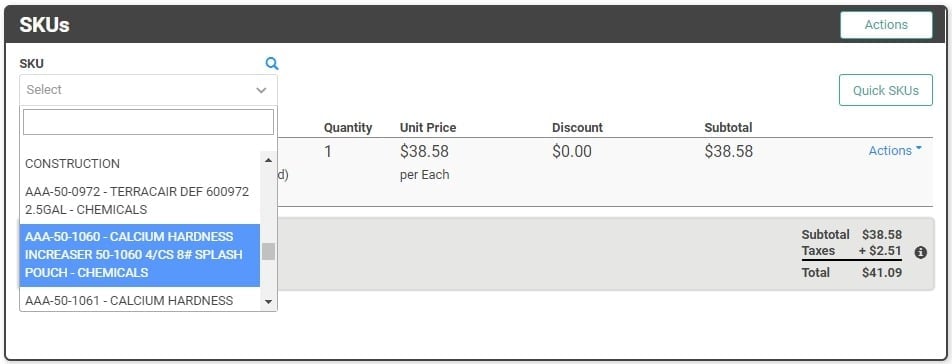
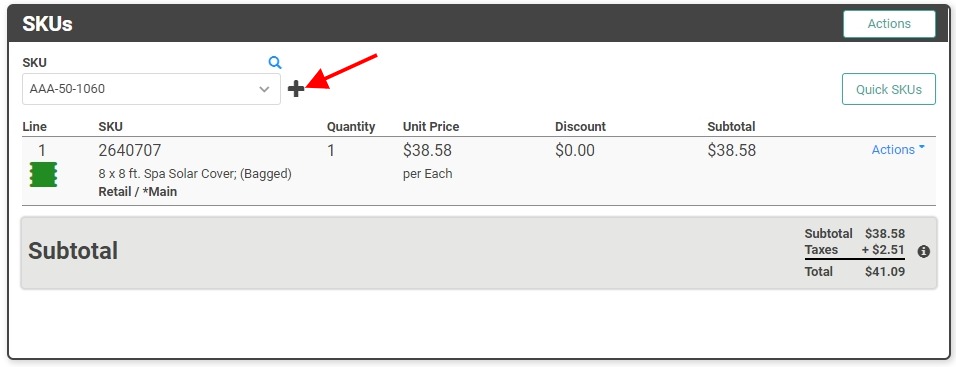
The SKU will appear in the list along with Total Amounts.
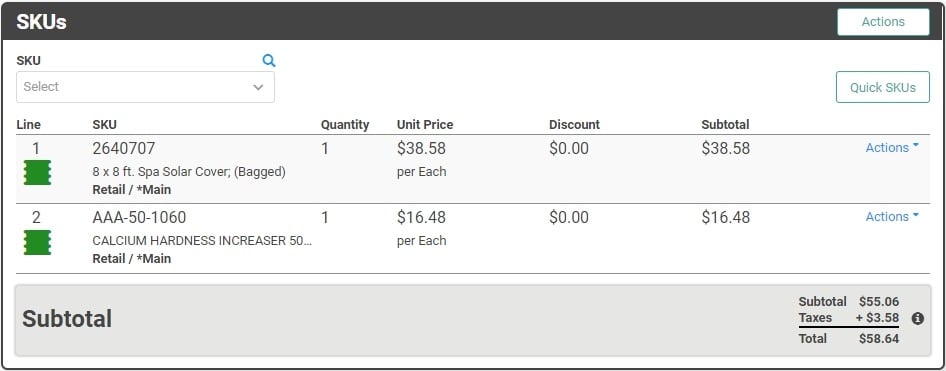
You can also use the magnifying glass to search for SKUs. 
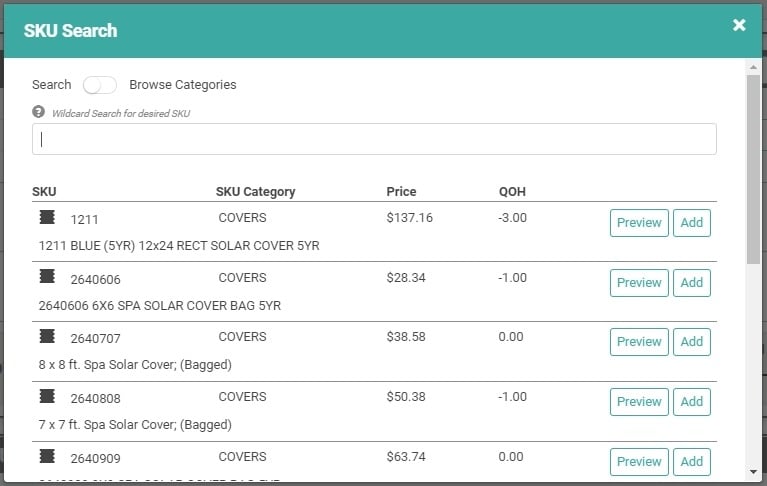
Using this pop-up window, you can search for SKUs or browse Categories. You can Preview the SKU Details by clicking Preview. 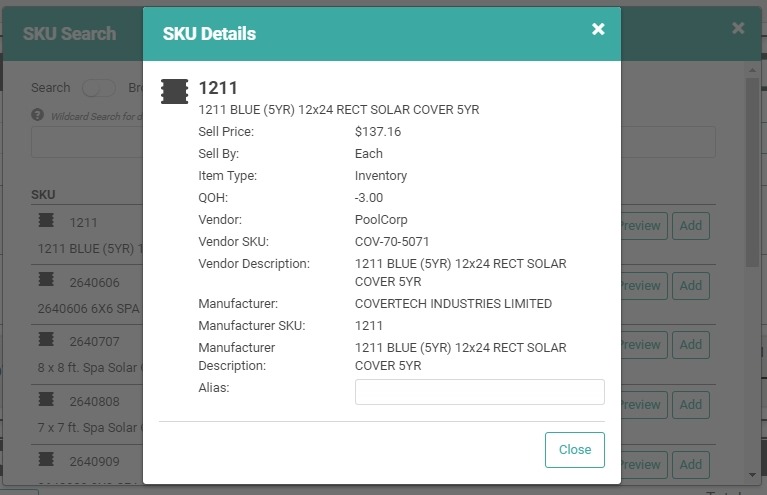
You can add the SKU with the Add button. To add multiple quantities of one SKU, click Add multiple times, equal to the desired quantity. Once you’ve added all the SKUs you’re looking for, click the X to return to the Sales Order Profile or scroll to the bottom of the window and click Close.
Finally, if you’ve set up Quick SKUs, you can use that to add SKUs. 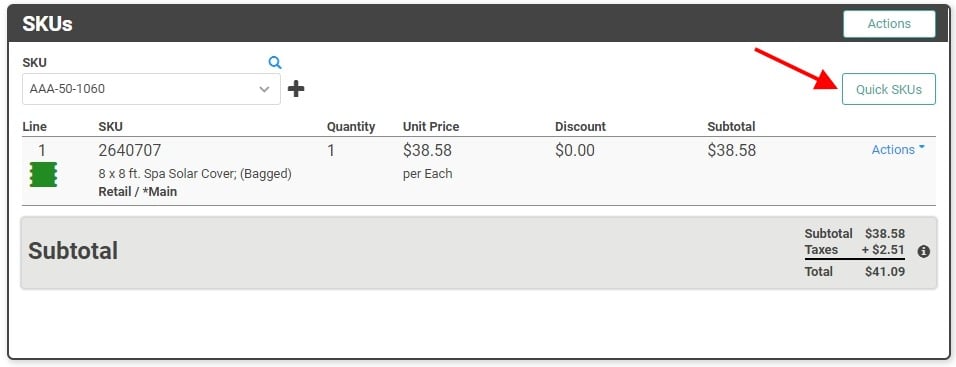
If you need to make adjustments to the SKU, including adding the Serial Number, click the Actions link on the line item and select Update. 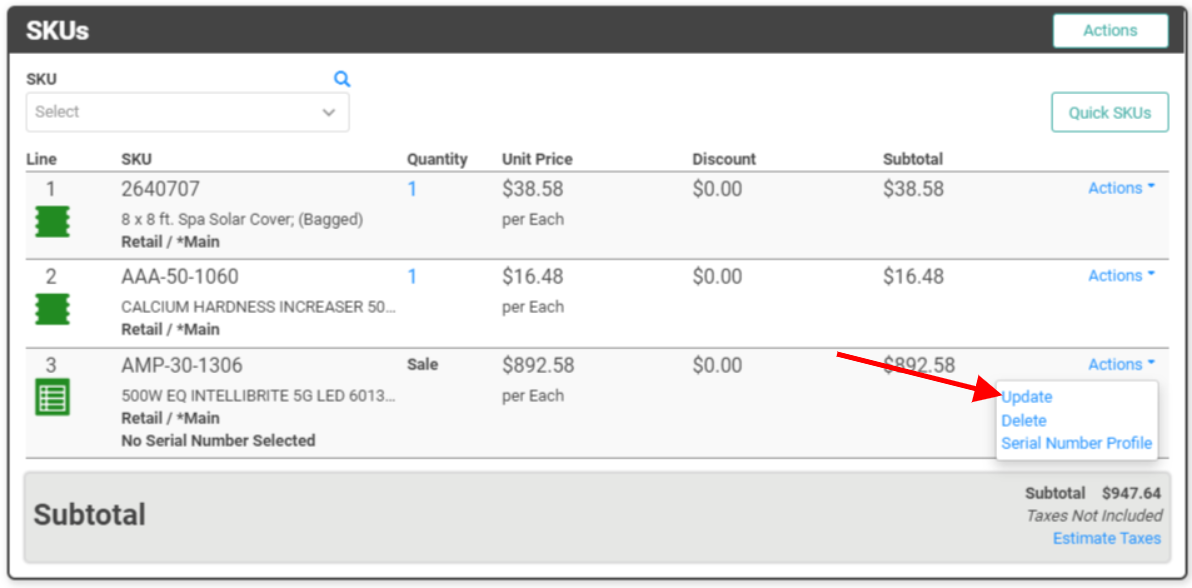
From here, you can designate the SKU as a Return, adjust the Price, apply a Discount, edit the Description (just for this Order, not the SKU Profile), add the Serial Number, and View or Edit the Personnel who added the SKU to the Order and the Date the SKU was added. Finally, you can toggle the Taxable button to change whether the SKU is taxable on this Order alone. 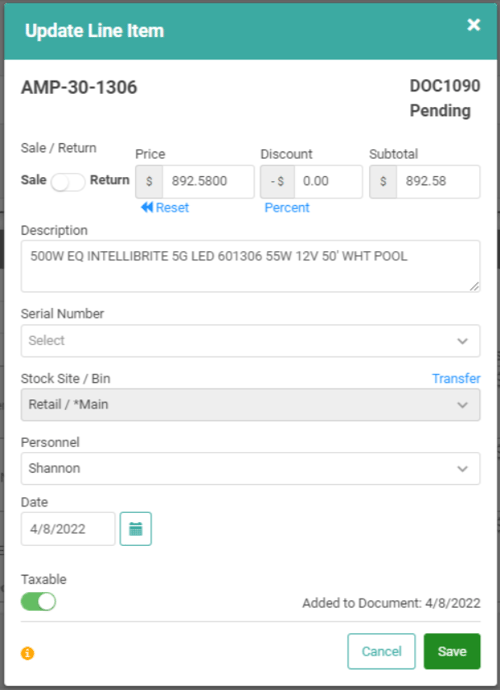
Once you’re satisfied with changes, click Save.
The SKUs box has an Actions button. This button opens a menu of additional Actions you can take on SKUs for this Order. 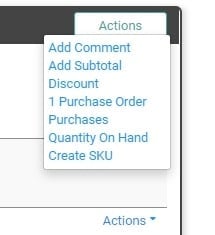
Add Comment
This allows you to add a comment immediately below the last SKU. 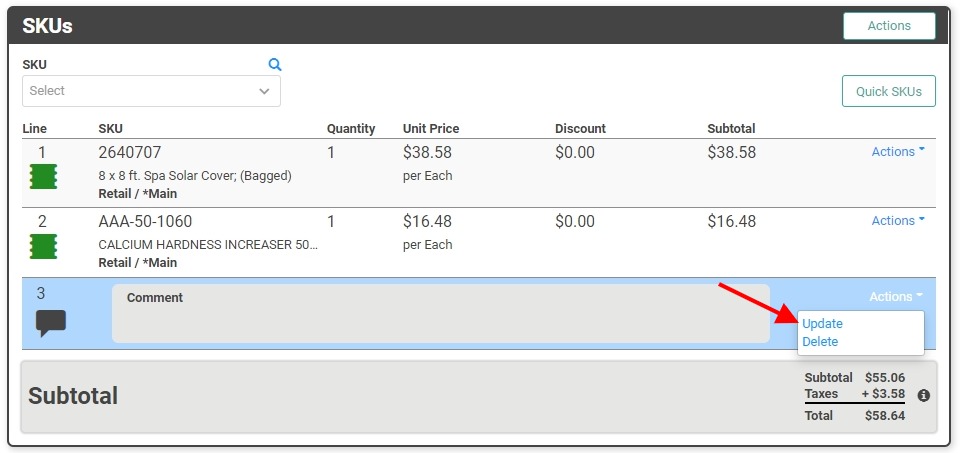
To enter the Comment, click the Actions link and select Update. 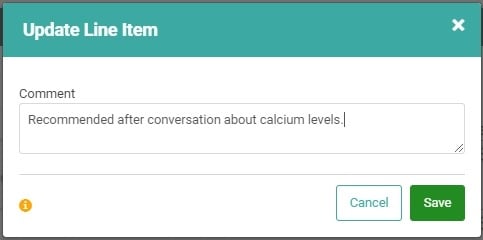
Once you’ve created the Comment, click Save. 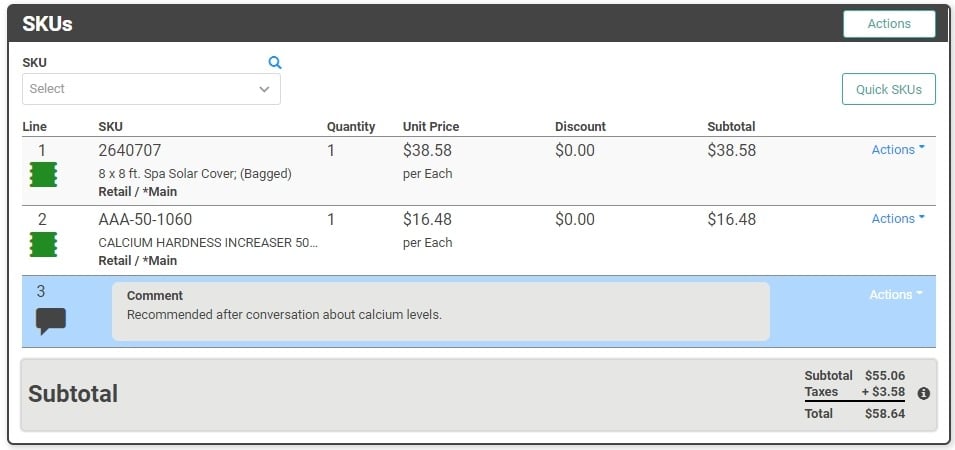
Add Subtotal
If you have a large Order, and you or your Customer would like to see a subtotal after part of the SKUs in the Order, you can use this button to add the Subtotal. This Subtotal does not include Tax. 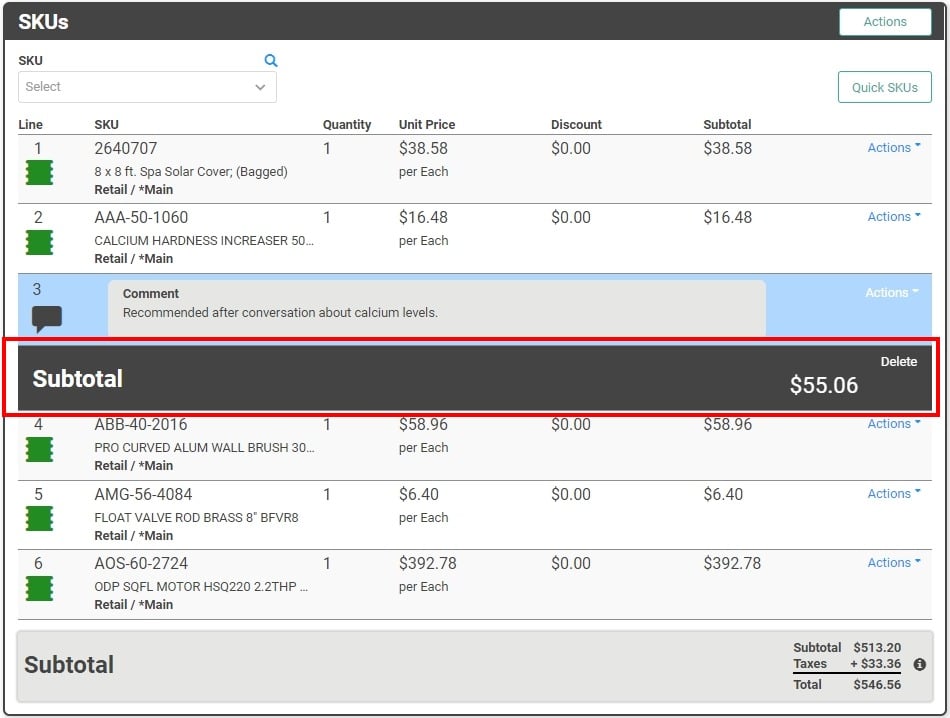
You cannot update or change the Subtotal, but you can Delete it with the Delete link.
Discount
You can apply a Percentage Discount to the entire Order. For more information, or to add a flat dollar amount Discount to the Order, check out How to Create Discounts on Orders. 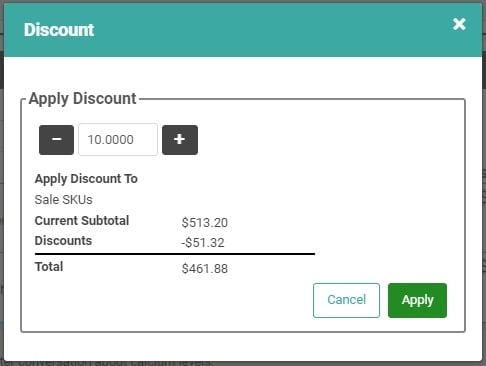
Purchase Order
You can associate the Order to a Purchase Order by adding it to a PO Wait List. The number of POs associated to the Order will appear next to Purchase Order in the Actions menu. You can access the PO Profiles by clicking this link. 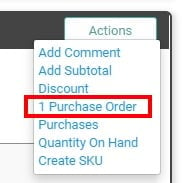
Purchases
You can quickly access the Customer’s Purchase History by clicking Purchases. 
The Purchase pop-up window allows you to search purchases, filter by Invoice Type, filter for SKU Type, choose a date range, or even Export the purchases list to Excel.
Quantity On Hand
This link allows you to quickly see the QOHs for each SKU on the Order. 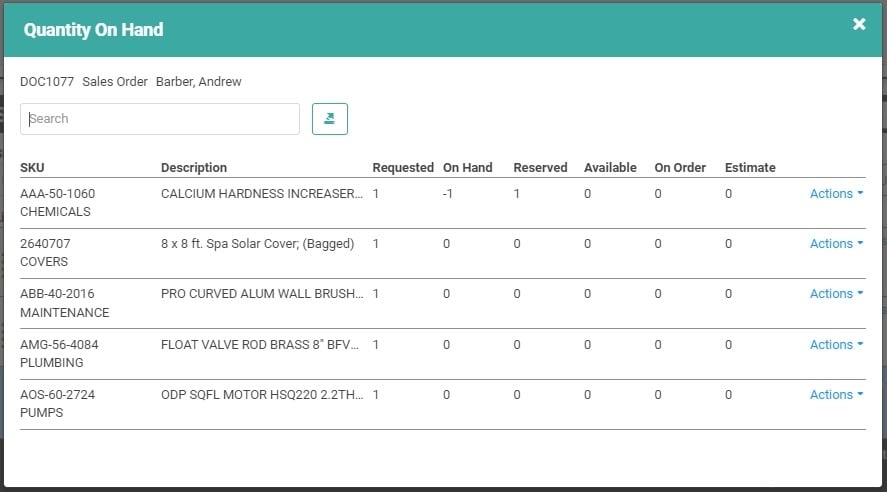
The Actions link next to each SKU line item allows you to View Stock Site Quantities for the SKU or create a Purchase Order for the SKU. 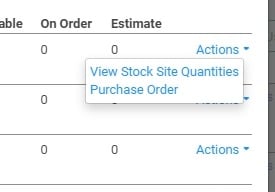
Create SKU
If, for some reason, you determine you need to create a SKU in the middle of creating an Order, you can use the Create SKU link to do so.
Kit SKU Actions
When you add a Kit SKU to the Estimate, click the Actions link on the Kit SKU line item to perform specific actions for the Kit SKU on the Order. 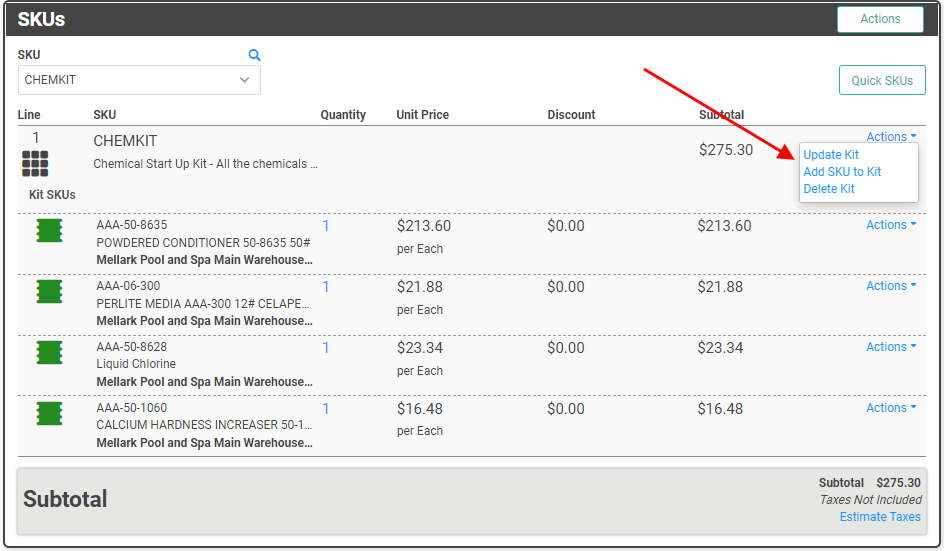
- Update Kit: Click to override the Kit Price for this Order only or to hide SKU line items or SKU line item prices on printed documents and customer-facing document links, including the Customer Portal.
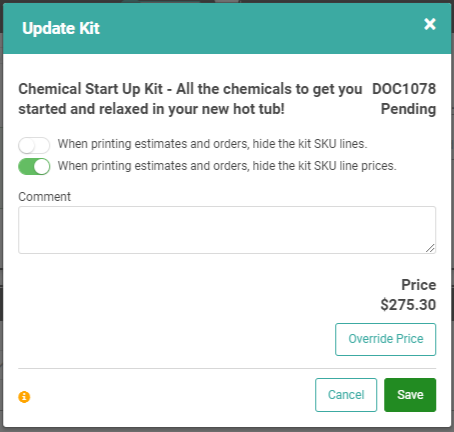
- Add SKU to Kit: Click to add an additional SKU to this Kit for this Order only. This does not add the SKU to the Kit permanently. This affects the current Order only.
- Delete Kit: Remove the Kit SKU from the Order.
IMPORTANT! Hiding Kit SKU lines also hides Kit SKU line prices but hiding Kit SKU line prices will not automatically hide the Kit SKU line items.
Deposits
To add a Deposit to the Order, click the ![]() button. If Deposits exist on the Order, you will see them listed in this box and the Order total updated to reflect the Deposits.
button. If Deposits exist on the Order, you will see them listed in this box and the Order total updated to reflect the Deposits.
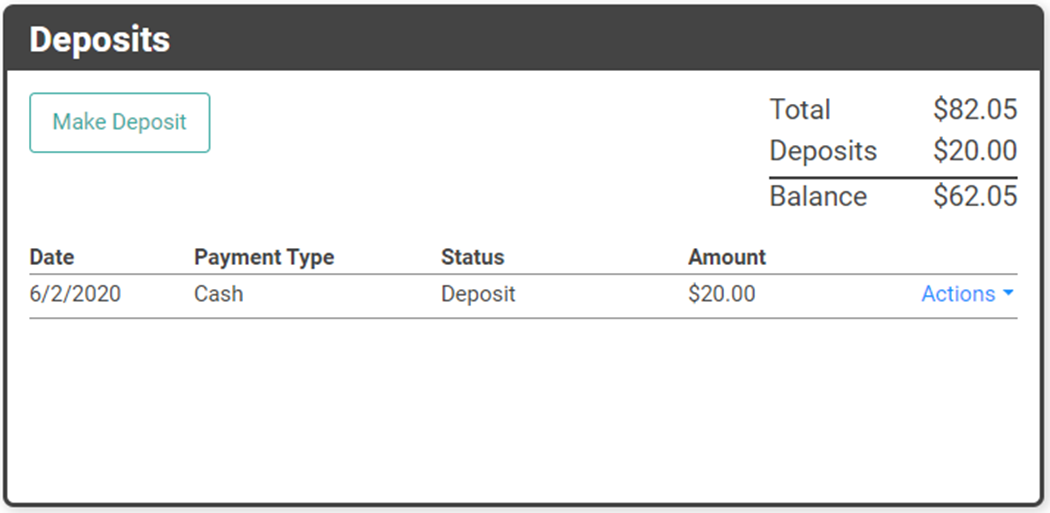
You can click the Actions link on a Deposit line item to visit the Payment Profile for that Deposit.
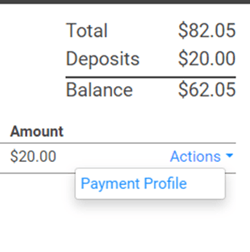
Marketing
You can Create and see list of the Opportunities linked to this Customer, as well as search Drip Campaigns in which the Customer is enrolled. You can use the Update button to link the Customer to an existing Opportunity.
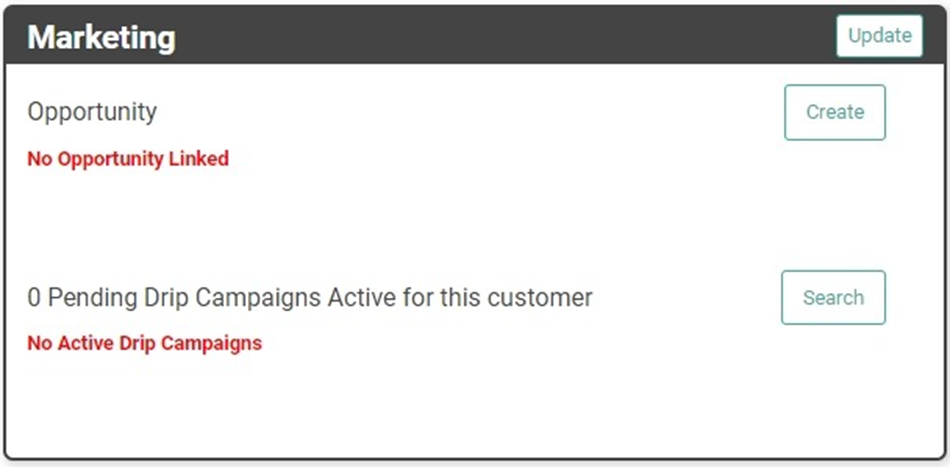
Images
This is where you can access or add images specific to this Document or the Customer’s Profile. Create and Manage Images and Files.
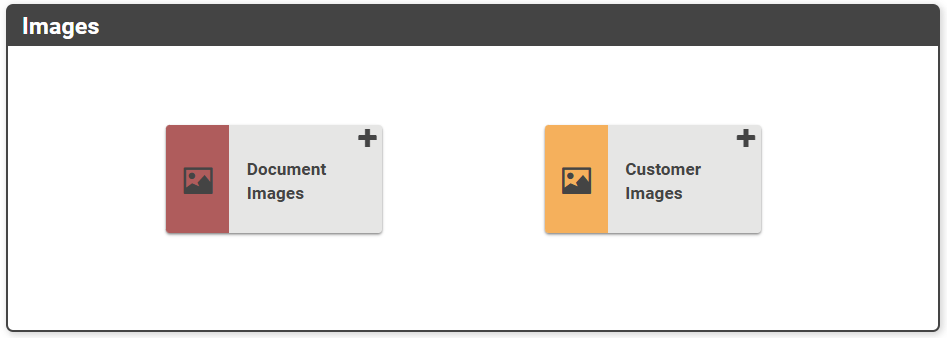
Estimates and Outcome
Once you’ve completed filling out the boxes with all the information, the Estimate is ready for next steps! Let’s just back up to the top of the page and look at the Estimates and Outcome boxes.

In the Estimates box, you can see the Document ID, Status, and Amount; you can also print a physical copy of the Estimate.
History
The History button will show you a log of the updates made to the Estimate, including User, Timestamp, and Action.
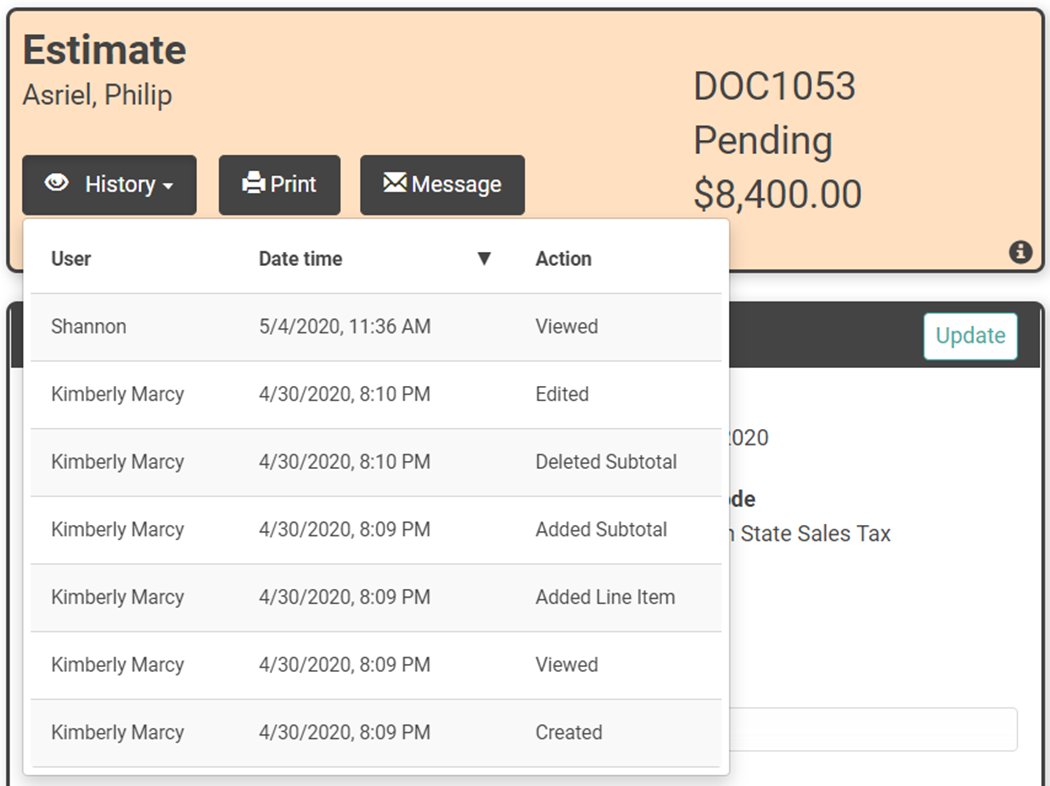
Message
To send an Email or Text message of the Estimate to your customer, click the Message button. The email is created/managed through Setup / Configuration / LOU Integrations / Email Messaging. Depending on the Customer Message Preferences, when you click the Message button on the Estimates Profile, LOU will open a pop-up box with the message you’ve configured as well as a link directly to the Estimate.
REMEMBER! If you have “Send Both” selected in the Customer Profile’s Message Preferences, this message button will only send the text message to the customer.
The ![]() button allows you to add the link to the Customer Portal to the Email.
button allows you to add the link to the Customer Portal to the Email.
REMEMBER! You do not have to click this button for your Customer to view the Estimate electronically. The Email or Text will automatically include a link directly to the Estimate.
Email Pop-Up

Email messages will include both the default link to the electronic document and an attached pdf. You may choose not to include the link by deleting it from the body of the email. You cannot opt out of sending the pdf.
Text Message Pop-Up
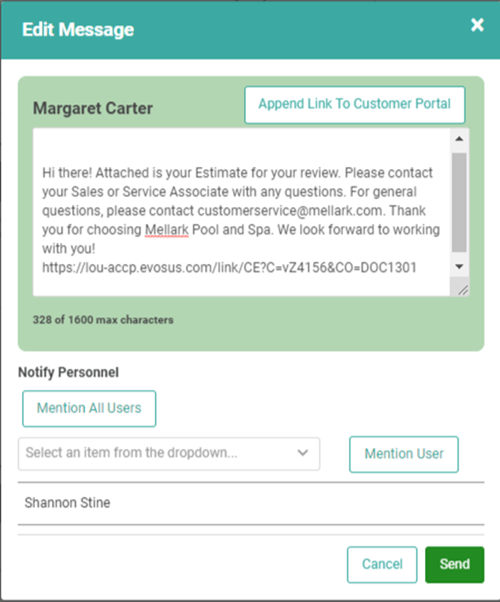
Text messages do not include a pdf as they are difficult to access on mobile devices. Instead, only the link to the electronic document will be included.
In addition to customizing the email or text message, you can notify additional Personnel about this message, creating a thread in their My Messages page. LOU will automatically include the Document Owner. If another user is sending the message, they will be included as well.
Once you have customized the email or text message and are ready to send, click the Send button and the Text or Email will be sent!
Customer Message Preference – Do Not Message
If your Customer has Do Not Message toggled on their profile, clicking the Message button will give you a warning, letting you know that they Customer’s message preference is ‘Do not Message’. It will provide the Customer’s contact phone number and email and allow you to click Send Email, Send Text, or Cancel out of the pop up and return to the Order. If you select either Send Email or Send Text, LOU will bypass the Do Not Message instruction and send the Email or Text.
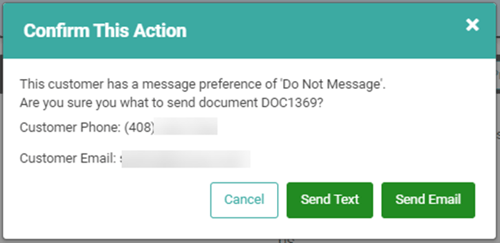
This is what the Customer will see when you send them a message.
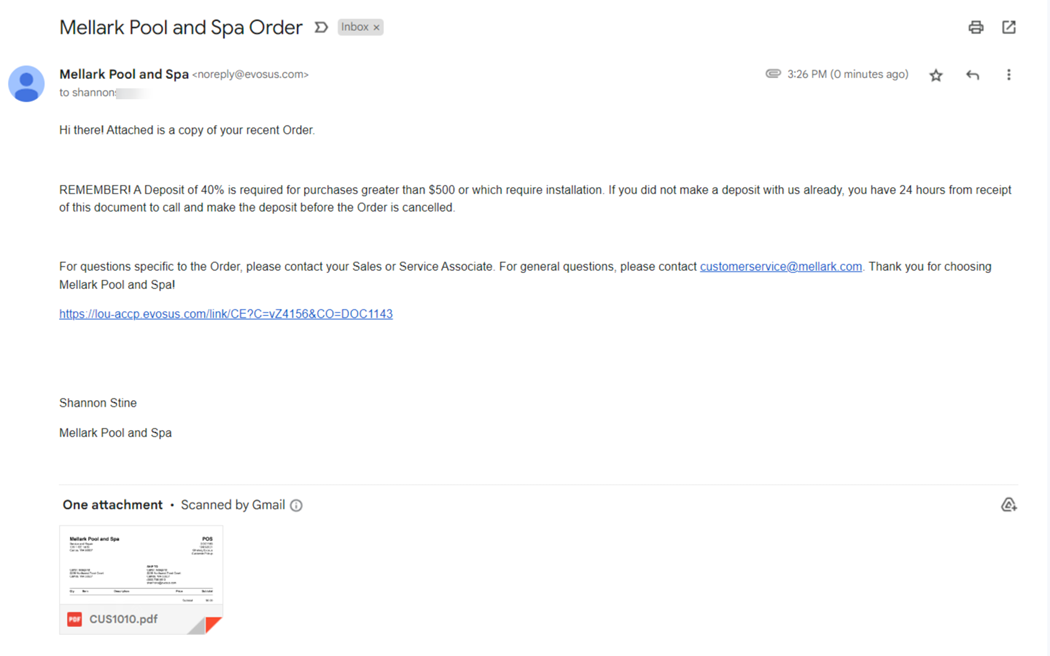
The Text Message will look similar.
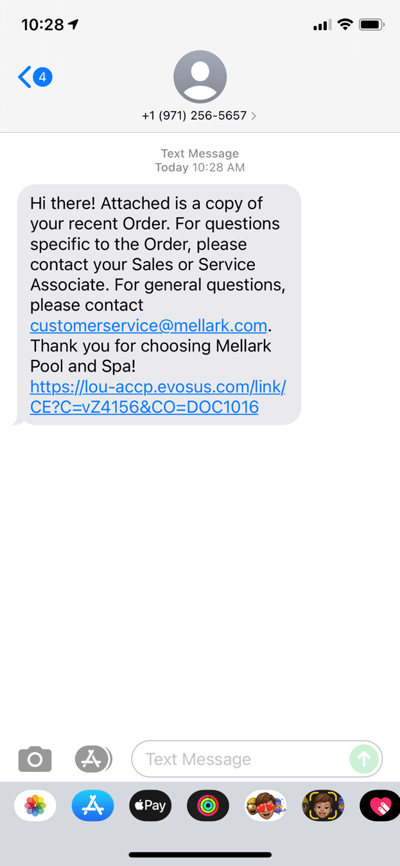
In the Outcome box, you can move the Estimate forward. You can mark it as a Win, Loss, or Expired, as well as Void the Estimate and Receive a Deposit for the Estimate.

To mark an Estimate as a Win, click ![]() .
.
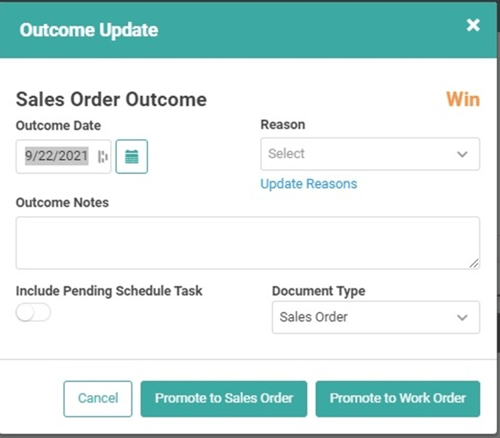
You must select a Reason. You can add Outcome Notes, toggle the Include Pending Schedule Task on, and select the Document Type. Then you can select whether to promote to a Sales Order or a Work Order.
REMEMBER! The Order created from promoting an Estimate will be Assigned To the Personnel who promoted it. The Completed Estimate will remain Assigned To the Personnel who created the Estimate even if they are different from the Personnel who promotes the Estimate. The Assigned To field can be updated on Estimates and Orders as long as the Document is not Completed.
To mark the Estimate as a Loss, click ![]() .
.
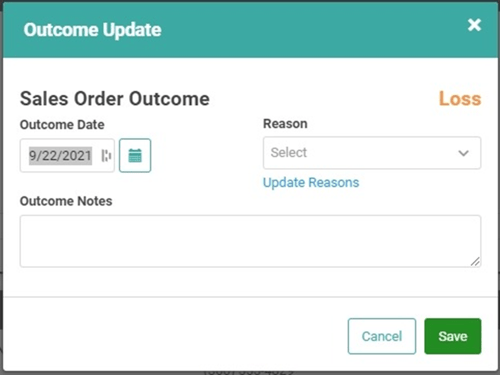
You must select a Reason. You can add Outcome Notes as well.
If you didn’t update the Profile box to include an Expiration Date, you can mark an Estimate as Expired manually by clicking ![]() .
.
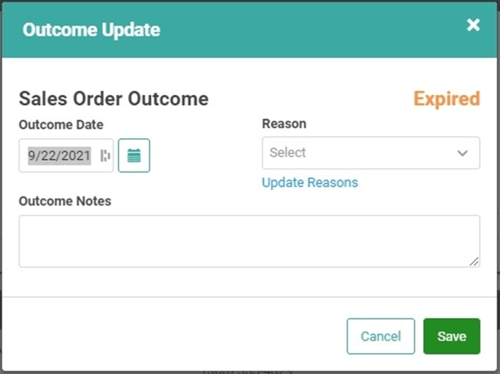
Click ![]() when complete.
when complete.
If you want to Void the Estimate rather than marking it as a Win or Loss, you can click ![]() and enter an Outcome Reason and relevant notes.
and enter an Outcome Reason and relevant notes.
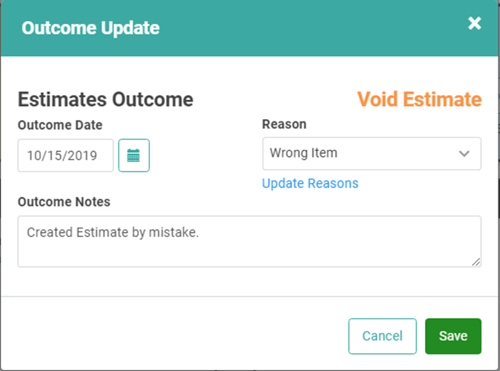
Click ![]() when complete.
when complete.
Finally, clicking ![]() will take you to the Payments page where you can process a Deposit for the Estimate.
will take you to the Payments page where you can process a Deposit for the Estimate.
Actions Link
On the main Estimates Search page, each Estimate has an Actions link with a few quick action buttons you can click.
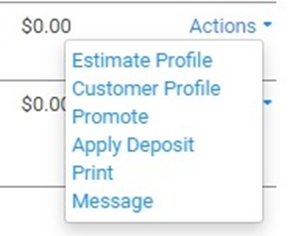
From this Actions link, you can quickly get to the Estimates Document Profile, the Customer Profile, Promote the Estimate, apply a Deposit, Print the Estimate, or Message the Estimate.
